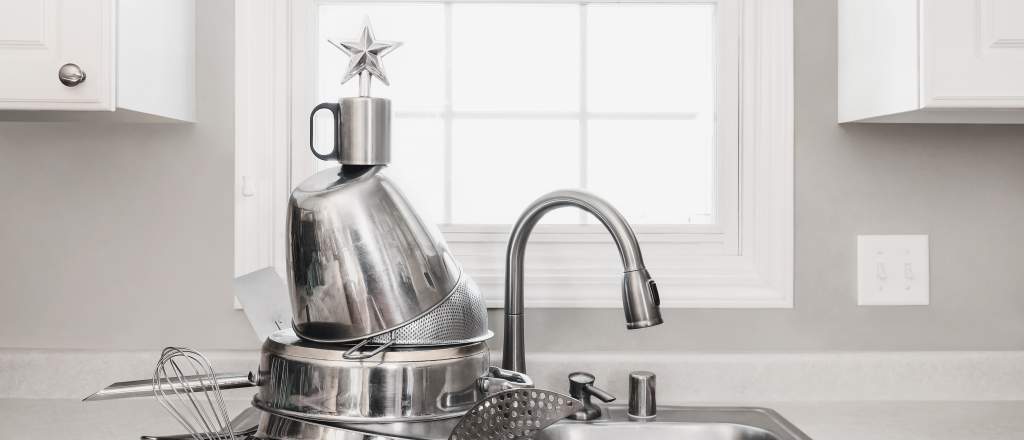Stainless steel is the perfect material for bathrooms and kitchens since it is strong and shiny. However, the moniker is a bit misleading, as everyone who has purchased stainless steel kitchen appliances knows it. The surface is susceptible to water stains, smears, and fingerprints. Originally, the term "stainless" was used to refer to a metal's resistance to corrosion under heat and humidity.
A stainless-steel pan may be used to cook almost anything without having to worry about scratching the surface because the material is non-reactive. However, if you don't clean it frequently enough, though, you can end up with a room filled with drab, grey appliances. So, the question uprises, how to clean the stainless-steel pans?
Post Highlights:
- Problems in cleaning Stainless Steel
- Things to know before cleaning Stainless Steel Pans:
- How to Clean Stainless Steel Pans of Discoloration
- How to Clean Stainless Steel Pans Appliances of Rust
- What are the Dos and Don’ts when it comes to clean stainless steel & Pans?
- List of Effective Ingredients and DIYs Against Steel
- How to Take Care of Stainless Steel Cookware
1. Problems in cleaning Stainless Steel
Although stainless steel is a durable material, harsh abrasives can scrape it or cause it to rust, so it's crucial to learn how to properly clean stainless-steel pans. Although stainless steel is made to withstand rust and corrosion, it is nonetheless susceptible to burnt-on messes and discoloration.
Everyday use leaves stains, water spots, and other difficult-to-remove marks, so it's critical to understand how to properly clean stainless-steel pans. These techniques for cleaning stainless steel pans will return them to their original glossy, spot-free appearance with a few common home items and elbow sweat.
2. Things to know before cleaning Stainless Steel Pans:
Make sure to consult the manufacturer's instructions for any specific washing advice before you start. Even though a lot of cookware is advertised as dishwasher-safe, stainless steel pans are usually best cleaned by hand washing. Always allow your cookware to cool completely before cleaning to prevent warping.
On your stainless steel cookware, never use strong cleaning agents like bleach or oven cleanser because they can permanently harm the surface. The same goes for abrasive equipment like steel wool.
Despite how easily it stains, stainless steel pans are shockingly simple to clean. Particularly, if you use a cleaner and microfiber cloth designed especially for this finish. Appliance cleaners for stainless steel pans are designed to remove oil without scratching and many often leave behind a protective layer to help prevent more fingerprints.
In comparison to simple cloths or sponges, microfiber cloths lift and trap dirt and oil while removing streaks more effectively and rapidly. When you encounter any oily streaks or difficult fingerprints, put in a little extra effort.
Supplies you need:
- Soapy water
- Nonabrasive sponge
- Spatula or wooden spoon
- Baking soda
- Commercial cleaner
Step #1: Scrubbing
Cleaning your stainless steel pan regularly involves using warm, soapy water along with a nonabrasive sponge.
Step #2: The stuck-on food
If there are still any food particles clinging to the pan, cover the residue with soapy water, heat to a boil, and scrape with a spatula. A wooden spoon can also work. The food needs to be simple to remove. After the pan has cooled, wash it as usual.
Step #3: Boiled water with baking soda
Using a more coarse cleaning technique may be necessary to remove tougher problems like burned food or oil. Take some baking soda from your cabinet for an easy and cheap solution to clean burnt stainless steel pans. Add a few tablespoons of baking soda and just enough water to the scorched skillet to cover the burned areas. Simmer after bringing it to a boil until the majority of the water has evaporated.
Step #4: The final scrubbing
Turn off the stove when the pan is cool enough to handle. Wash in heated, soapy water after using a nonabrasive sponge to remove residue. As an alternative, you can clean stainless-steel pans by following the manufacturer's instructions and using a commercial cleaner like Bar Keepers Friend.
3. How to Clean Stainless Steel Pans of Discoloration
You may find that after cleaning your stainless steel pans, the surface has developed some rainbow-colored discoloration. You're not alone if you've ever seen this strange, vibrant film on your stainless steel pans. Everything is based on science! Chromium, a hard metal, is frequently included in stainless steel pots, helping to prevent rust and corrosion.
If you combine oxygen with chromium, you can create a private rainbow show. It acts as a thin protective covering that transforms into a different color when exposed to air and intense heat. But relax—entirely it's secure.
Supplies You Need:
- Vinegar
- Boiling water
- Soap
- Baking soda
- Damp sponge
Step #1: Using the vinegar
Pour some vinegar into the pan, then use a soft sponge to wipe the surface down before properly rinsing and drying it.
Step #2: Boiling water and vinegar
Your stainless steel pans may develop a white, hazy residue as a result of using hard water. To remove this chalky buildup, heat a solution of one part vinegar to three parts water to a boil in the pan. Let it cool, then wash with soap and water.
Step #3: The support of baking soda
To remove any minute water marks from the pan, use a moist sponge coated with baking soda. Dry your kitchenware as soon as possible after cleaning it to avoid wet marks in the first place.
4. How to Clean Stainless Steel Pans Appliances of Rust
Rust can form on stainless steel. Your appliances' stainless steel finishes, which have a smooth, silvery surface and luxury aesthetics, might develop minute spots of rust.
If something goes wrong during the manufacturing process, stainless might potentially rust. For instance, contaminants that become ingrained in the stainless surface during manufacture may subsequently cause corrosion.
It is advisable to adhere to your appliance's brand's instructions or contact the manufacturer's customer care line for guidance tailored to your model. After removing the rust, wipe down the area with a soft cloth and clean water before drying.
Watch out for regions where rust has previously been present and has been removed because they are more prone to rust once more in the future.
Supplies You Need:
- Cloth
- Water
- Baking Soda
- Stainless Steel Polish
Step #1: Preparing the mixture
Add baking soda to warm water. Use a cloth or microfibre cloth to scrub the surface.
Step Number 2: Scrubbing the rust off
Rub gently on the area to remove the rust off the surface.
Step Number 3:
The area should be polished with stainless steel polish, then blended.
5. What are the Dos and Don’ts when it comes to clean stainless steel & Pans?
Do’s:
Examine the manufacturer's directions before you begin your search for the best cleaning solution. You may learn a lot about cleaning stainless steel pans and equipment there. They frequently offer recommendations for the best stainless steel cleaners and make note of cleaners that can harm the finish. When it comes to cleaning a stainless steel refrigerator or oven, you can put your trust in the manufacturer. By following their guidelines, you can keep your equipment looking brand-new.
Here are a few tried-and-true cleaning techniques that are effective on most finishes, provided they don't conflict with the cleaning instructions on your stainless steel pans appliances.
For most cleaning tasks, a gentle cloth soaked with hot water will be enough.
- A glass cleaner works well to remove fingerprints.
- To remove streaks, wipe against the grain.
- To avoid water stains, towel off after cleaning.
- If necessary, you can use a commercial cleaner to clean stains from stainless steel, but carefully read the instructions and perform a spot test first.
Don’ts:
Your stainless steel pan’s surface will be scratched by steel wool or brushes, which will increase the likelihood of rust and discoloration.
Cleaning agents with abrasives will dull the finish and scratch the surface.
Stainless steel will be stained and harmed by chlorine-containing cleaners including bleach.
Don't let the residue from filthy water and cleaning products dry on your stainless steel; doing so will degrade the finish and may result in permanent stains. Some tap water has a strong taste and might leave stains. Instead, utilize distilled or filtered water.
6. List of Effective Ingredients and DIYs Against Steel
The most innovative industrial cleaner might not be the best or the safest one for stainless steel pans. For cleaning stainless steel pans, there are numerous alternatives to potentially hazardous industrial cleaners. See for yourself by using these homemade cleansers on your appliances, but always spot-test any stainless steel cleaner before applying it to the entire surface.
1. Olive Oil and Vinegar
Two microfiber cloths, distilled white vinegar, and olive oil are required.
Give your stainless steel pan a close inspection to discover the grain. To get rid of filth, grease, and grime, dampen your microfiber cloth using vinegar and massage against the grain. Olive oil is used to dampen another microfiber cloth while the vinegar dries. To make the oil work, wipe it in with the grain. Your stainless steel pan will be cleaned, protected, and polished with this quick and simple technique.
Using olive oil alone can also be proved useful. Use a very small amount of olive oil on a cloth and buff it into the exterior of your stainless steel refrigerator to make it shine and prevent fingerprints. Buff in the direction of the grain. After that, wipe away any extra with a dry cloth. The surface will stay shiny and stain-free for a prolonged duration even though it won't feel oily.
2. Baking Soda
Burned or caked-on dirt and grime on stainless steel surfaces or pots and pans usually require a little more care. Make a soft paste with water and baking soda, apply it to the stain and let it sit for around 20 minutes. After that, scrub the area with a towel that has been soaked in water and dish soap solution. To prevent scratches, it's crucial to work parallel to the grain and with a soft cloth. Make sure to rinse and dry completely.
3. Baby Oil and Dish Soap
Three microfiber cloths, warm water, dish soap, and baby oil are all required.
Mix one quart of hot water with one teaspoon of dish soap. Clean with the grain while drenching your cloth with the solution. One teaspoon of dishwashing liquid and one quart of water should be combined. Clean, warm water should be used to wet clean microfiber cloth to remove the residue. After allowing the finish to dry, rub in the baby oil while going with the grain.
4. Steam Clean
A steam cleaner that comes with a nozzle attachment can also be used to sanitize stainless steel pans. The surface will be cleaned by steam and can then be dried with a soft cloth. Beware of using a brush attachment or any other hard cleaning instruments on stainless steel because they can easily scratch the material.
7. How to Take Care of Stainless Steel Cookware
The secret to maintaining your stainless-steel cookware spotless is prevention. Refrigerated ingredients, such as raw meat, should stay at room temperature for ten to fifteen minutes before cooking. It is because cold foods are more prone to stick to a hot pan.
Always warm your pan before adding oil, and then allow it some time until the oil is hot before beginning to cook. To avoid pitting corrosion, which results in tiny, irreversible dents in the bottom of your pan, wait to add salt to pasta and other meals until the water is already boiling.
You can increase the lifespan of your stainless-steel pans and maintain the excellent condition of this often used cookware by following these easy suggestions.
Conclusion:
The beautiful glitter of your brand new stainless steel pans, oven, or other appliances immediately illuminates your kitchen when it first arrives. The same holds with new cookware and sinks. However, by week two or three, small fingers, watermarks, oil splatters, and general wear and tear may have begun to diminish the brilliance of these things.
Fortunately, no matter how old or well-used your stainless steel cooking utensils may be, these simple methods will bring back their gleam. Hopefully, this article gives you all the answers to how to clean stainless steel pans.
If you're looking for great stainless steel pan recipes check out our great selection of pan seared scallops!






Leave a review or comment